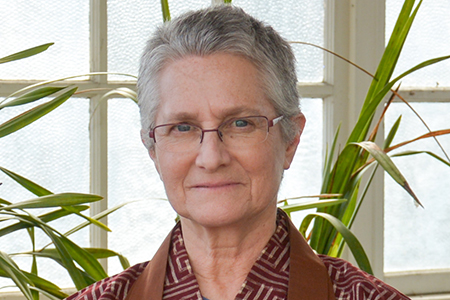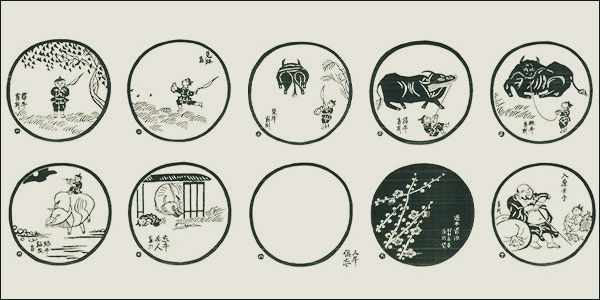
By Cat Li Stevenson
Kyoshin Wendy Lewis has been practicing at San Francisco Zen Center since 1987, including living for six years at Tassajara. She was ordained by Sojun Mel Weitsman in 1997 and completed Dharma Transmission with Eijun Linda Cutts in December of 2012. She will be teaching an online class this Fall on The Ten Oxherding Pictures 10/08-11/19.
Sangha News: Could you tell me what the Ten Oxherding Pictures is, and how it relates to Zen?
Wendy Lewis: The Ten Oxherding Pictures is one of the four basic Zen texts*. What it outlines is the spiritual path. It’s based on the concept of Buddha nature—our original face, and tathagata-garbha, the seed or womb of all buddhas. It’s not taught very often, partially because it describes a spiritual path.
It’s about studying and knowing the teachings, and then, at various points, having the teachings and path drop away. We don’t usually see Zen as having a “path” quality. Sometimes this kind of teaching is called steps and stages. But I think it’s very enriching to practice and have a sense of a path. And the point of the Oxherding Pictures, as in any spiritual path, is that you’re never finished, you’re always being informed by the previous steps no matter which step you have reached.

SN: Could you speak more about the paradox of not having a path and having a path in practice?
A path is considered to be an aspect of Buddhist practice. There is a paradox regarding a path. For instance, Dogen says practice and realization is the same, but then he doesn’t outline a path of practice [laughter]. So you’re always caught. Are you stuck on the path? Are you deconstructing it?
Blanche told a story once about how she went to speak with Suzuki Roshi and said, “I counted my breath to ten!” And he responded, “You don’t sit zazen. Zazen sits zazen!” We have these instructions to count to ten, and yet we’re not supposed to count to ten. How do these practices and deconstructions happen at the same time?
SN: OK, so how do they? [laughter]
By applying meditation practices and mindfulness—they have the quality of some type of goal and process, and applying the precepts, and something in Buddhism we call “sraddha” or faith—why do you do this, if you don’t have some urgency or inspiration to go on? So, I think we have these teachings that we can actually apply—they’re very difficult, and also very simple. In this simplicity of being direct.
SN: Beautiful. Tell me, are these images helpful only to monastics or do they have relevance in today’s householder life?
That’s a very good question. Yamada Mumon, the person whose lectures we will be studying, gave these lectures to a group of priests in training, but he presented them in a very colloquial manner; Sheng-yen, whose teaching on the oxherding pictures we are also referring to, taught monastics and lay practitioners. They’re deeply applicable for both or for all. And that’s the point of the pictures, or the path, is that it’s accessible. As he said, it’s actually fun! There’s something fun about having a path—seeing yourself, taking yourself seriously, and struggling. I think it can apply no matter what your circumstances are. You can always engage in a path.
SN: Interesting. In the secular world, is this like a hero’s journey?
I think it is. There’s part of the spiritual path that’s called “dark”—because you’re learning something you didn’t already know. That’s part of the hero’s journey: you see you’re limited, and how do you negotiate that and continue your development to see what happens? That’s the hero’s journey—it is to keep going.
SN: I see. So, do you have to be an artist to take this class?
Absolutely not. In fact, I put this in the description on the website as an invitation, not a requirement. The idea is: how would you interpret the images of the ox and the spiritual seeker? Any variety of images could convey those ten points along the path. There are great examples online of how people interpret these—some are very artistic and detailed, and some are cartoon-like.
SN: Why are you interested in the Ten Oxherding Pictures and teaching this class?
I’m very interested in the spiritual path—the developmental path of spiritual understanding. Also, I was interested in teaching the class because it’s taught so rarely. It has been many years, maybe even decades, since someone has taught it at SFZC. I’ve been studying this book for years. I thought maybe it was a good time for this class to be offered.
SN: How is this class relevant to the times we’re in now?
When I decided to teach this class, I didn’t know we’d be in these times. I think the ideology of Buddha-nature is very appropriate for seeing how we are dealing with this, what’s coming up around it, some of the issues around justice and our strange systemic cultural rigidities. How do we become more flexible? And soften? Some of the teachings of Buddha-nature speak to that.
If everyone has Buddha-nature, then why are we dividing things in the way we are—what is the point? So I think some of the teachings of Buddha-nature are very relevant. They’re also a little challenging; but developing a critical view of the teachings can be very refreshing. Studying this teaching with a critical eye is also appropriate for our times.
SN: Wonderful, any parting words?
One of the aspects of the Ten Oxherding Pictures is that there are points where people leave the path. It’s not a failing, it’s a curious place where you can feel overinflated or discouraged by that quitting. So I think it’s interesting to look at the path from that perspective, do we really want to do it? It’s not good or bad.
The tenth picture “entering the marketplace with extended hands” or “returning to the marketplace with gift-bestowing hands” can be interpreted in different ways; how do you get there and what does that description mean? This tenth picture and its meaning is symbolized by Hotei, and he’s associated with Maitreya—the future buddha. That is very interesting in terms of what development has taken place by following the teaching of the Ten Oxherding Pictures.
*The others are Faith in Mind, Song of Enlightenment, and The Principles of Zazen.











